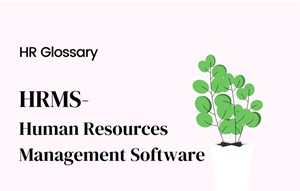Attrition

[Sommaire]
What is attrition?
In HR, attrition, also commonly referred to as “churn” or “turnover”, it refers to an organization deliberately reducing the size of their workforce by voluntarily not replacing employees when they leave.
Attrition is a form of workforce management that organizations use to cope with fluctuations in demand for services or products by reducing operational costs. For that reason, churn may be seen as good news in some cases, and it also requires careful planning, so attrition does not cause more damage than it prevents.
In attrition, employees authorized to work in a particular area or company voluntarily decide to leave that organization for personal reasons, such as pregnancy or retirement, a reduction in the workforce due to downsizing and unemployment, downsizing of the organization's services, relocation of jobs outside the boundaries of the country.
Attrition is controversial; some managers believe attrition can be very costly (estimated at up to 50% of the departing employee's annual salary) for an organization. Others recognize attrition as a natural consequence of having employees and may encourage attrition so long as it does not affect its performance.
How can attrition be reduced?
In attrition models, attrition is often predicted based on an analysis of one or more factors related to attrition that have been identified through the results of a survey. In survey-based attrition models, employees are asked about their intentions to leave. For example, respondents may be asked how likely they are to remain with the organization in the coming year, and how different important aspects of work are to their decision to stay with the organization.
The attrition model may include drivers, such as demographic characteristics (e.g., age), tenure on the job, working conditions (e.g., schedule flexibility), and organizational factors (e.g., mission).
Based on attrition models, managers can develop strategies to reduce attrition. For example, attrition models may predict that attrition is higher among younger employees with fewer years of tenure and lower education levels, so managers can target these groups with retention initiatives such as tuition reimbursement programs for college graduates.
Attrition models provide a way of quantifying turnover risk at the individual level so organizations can focus limited resources on those employees who are most likely to leave.
That said, a degree of employee turnover is normal. Even for the best-loved employers, staff will leave for reasons such as retirement, moving to a new area, or choosing to change career.
What factors can cause attrition ?
As an HR manager in a company, you have already seen employees go for many reasons: they got a better offer, their spouse got transferred, or they could not stand the company anymore. These are all considered turnover due to causes related to the job or company. But attrition can also be caused by issues outside of the job.
The following factors can cause staff attrition:
- Lack of opportunities for advancement or professional development
- Inequality between salary and workload
- Role conflict (e.g., expectations that cannot be fulfilled)
- Inadequate training and skills to perform tasks
- Lack of supportive management
- Lack of recognition (e.g., for accomplishments)
- Low job satisfaction, poor pay
- Poor working relationships with peers, subordinates, superiors of with hr professionals
- Personal reasons (e.g., caregiving responsibilities).
What can attrition tell us?
Employee turnover provides clues into the quality of your recruitment and hiring practices, the attrition drivers that are present in your organization, your churn management strategy, whether you have provided enough opportunities for employees to develop new skills within their current role, and whether you are competitively paying market rates.
The employee attrition rate can be an indicator of how well companies retain talent. When churn is rising rapidly, it may be a sign that attrition drivers are rising too.
An annual attrition rate lower than the industry average might indicate that you are able to attract and retain talent more effectively than your counterparts. However, an attrition rate higher than the industry average might mean there is something about your work culture or turnover management strategy that needs attention if you want to remain competitive.
When attrition levels are high, employee morale may suffer and frontline managers may not have enough time to focus on critical tasks that aren't being completed due to higher workloads
Thriving businesses will typically replace employees who hand in their notice. But occasionally, companies may stop hiring new employees. This might be due to a restructure or financial difficulties. Used this way, turnover can feel like a less disruptive way to reduce employee numbers than by calling for redundancies.
How should you calculate the attrition rate?
Attrition rates are often expressed as a percentage of an average number of employees. If an attrition rate is stated without this qualifier, it is assumed to be the employee attrition expressed as a percentage of total headcount.
Calculating an organization’s turover rate uses a simple equation. You first take a set time period – for instance, six months. Divide the number of employees that have left during that time period by the total number of employees in your organization, and then multiply that by 100 to give you a percentage.
For example : 14 employees left ÷ 158 employees employed x 100 = 8.9% attrition rate.
It can also be expressed as attrition rate = (attrition ÷ average employment).
What are the attrition drivers?
Employee attrition drivers are factors that may illustrate the global employee satisfaction. The main attrition driver is poor organizational fit, which can be defined simply as employees feeling the organization does not value them or their skills. Other staff turnover drivers are more complex and include job attitudes, lack of opportunities to learn new things at work, lack of upward mobility or advancement, limited recognition and lack of support from managers.
Organizations should seek to reduce attrition drivers as a means of improving churn rates. This is because attrition models provide information about where churn might be reduced, attrition drivers suggest where attrition levels can be changed and attrition-related factors reveal how churn might be influenced.
How does employee attrition affect a workforce?
Attrition affects a workforce in two ways: reducing the number of available employees and changing the organization's remaining employees. The impact staff turnover has on a workforce is heavily influenced by whether is it voluntary attrition or involuntary.
Employees who voluntarily leave their jobs are more likely to be satisfied with their work, have stronger skills and perform better on the job relative to employees who are involuntarily terminated. Voluntary turnover is often less disruptive in other words, attrition-replacement activities are carried out before rotation occurs.
On the other hand, involuntary attrition negatively affects employees who are left behind must pick up the slack for their missing colleagues. Involuntary turnover can also lead to high turnover rates among remaining employees as they seek opportunities elsewhere to find more suitable working conditions.
When staff attrition occurs during a period of strong economic growth, churn may be less disruptive because employees that are left behind must assume only the work of those who have departed. However, attrition can become more disruptive during periods of high unemployment when highly skilled employees seek employment elsewhere.
Attrition is not limited to frontline workers; attrition occurs across all levels and functions in organizations. The churn rate is often higher in lower-level employees such as frontline workers and sales clerks, whereas employees leave rates tend to be lower in upper management.
Why is understanding the attrition rate important?
Measuring employee attrition will give you an insight into how many employees are leaving your organization. It is important to understand how turnover affects your workforce, and attrition models provide insight into the relationship between churn and factors such as job satisfaction and turnover intentions.
Understanding attrition is an integral part of any talent management strategy that seeks to improve engagement and retention. Churn models enable organizations to forecast attrition rates in order to plan replacement activities in a timely manner.
However, turnover models are not limited to executives. Frontline managers can use attrition models to obtain forecasts for their teams or departments to better allocate resources and train employees to reduce attrition rates. Turnover analysis can help organizations target training programs by position, location, length of service or other factors that impact staff attrition.
The trick is not to look at the number in isolation, but to review it in comparison to other figures. For example:
- You can compare attrition rates against differing time periods to understand if changes in operating conditions or management have affected turnover
- Compare attrition rates by team. Do some teams have a higher turnover than others, could this be related to the roles in this team or the team culture?
- How does your churn rate compare to your industry?
With an understanding of your company’s or team’s attrition rate, you can use this data to plan for future changes. For example, if you need to reduce employee costs but don’t want the upheaval of redundancy, then knowing the staff attrition rate will indicate how quickly you will be at your target.
It’s important to understand that relying on churn to reduce your workforce reduces the control you have over who stays and who leaves. Ambitious and talented employees may well be tempted to join other organizations if you don’t take steps to keep them; those star employees who you counted on to grow your company may be the ones who leave.
The attrition rate is useful to an extent but shouldn’t be relied upon to manage the size of your organization. The negative side to churn is that it is a passive approach to managing employee


